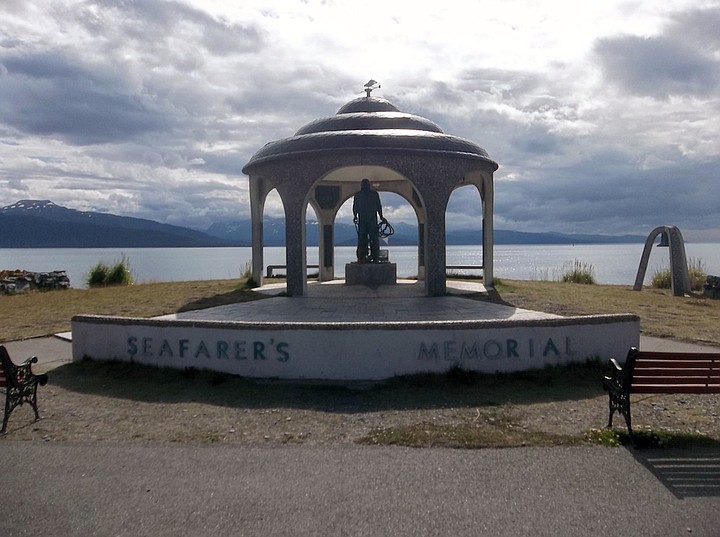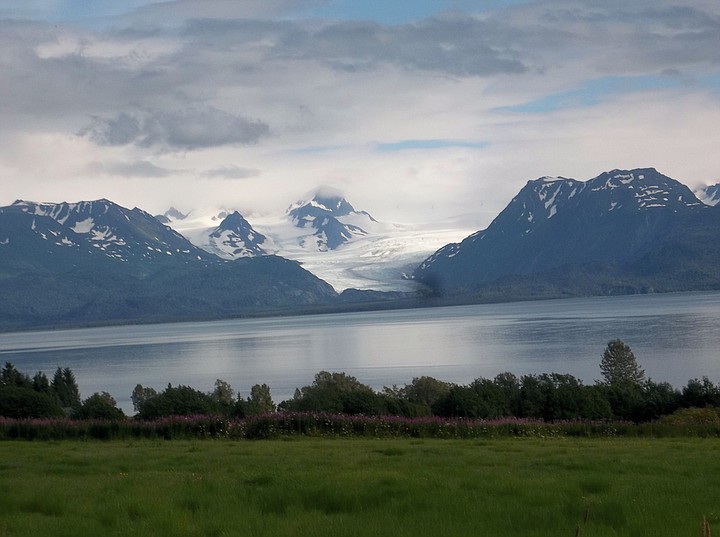 Facebook
Facebook
 X
X
 Instagram
Instagram
 TikTok
TikTok
 Youtube
Youtube

In 1896, Homer Pennock arrived in a sleepy seaside hamlet in southern Alaska hoping to strike a fortune. He managed the Alaska Gold Mining Company, but his mining ventures ultimately failed. Pennock left the area after a year to search for gold in the Klondike. He did lend his name to a lovely town, though.
Homer, Alaska, the self-described "halibut fishing capital of the world," is a little community of about 5,000 on the Kenai Peninsula. It’s worth visiting, if for nothing more than the magnificent views on the route from Anchorage. If you enjoy fishing, however, you may find it the closest thing to heaven.
Halibut and salmon fishing are serious business here. The Homer Halibut Fishing Derby offers thousands of prizes to winning participants. This year’s winner won $10,000 for his 323-lb. catch – an extreme example, but catches of more than 50 pounds are common.
The Homer Spit, a five-mile stretch of land that stretches out to Kachemak Bay, is where you can pick up the fresh catch of the day. I watched them being displayed at Buttwhackers, a fish cleaning business where a sign explains, “we pack ‘em, rack ‘em, whack ‘em and sack ‘em.”
In front of Buttwhackers, the Salty Dawg saloon with its distinctive lighthouse tower is the site of many a spellbinding sea tale. Order a brew and weave a tale of your own.

Across the street, the Seafarers Memorial (left) is a sober reminder of the hazards of the seafaring adventure.
In front of the memorial lies a plaque with an inscription of the poem The Sea, an elegy to those whose fate is to have the sea as “a final resting place.” A memorial bell contains the inscription, “The bell tolls for all the souls set free upon the sea.”
The Spit is a worthwhile spot to visit, but you may not find much solitude there; rarely have I seen so many RVs in one place. For a quiet spot to appreciate the gorgeous view of the surrounding mountains, volcanoes and glaciers, park at Land’s End Resort at the end of the spit and walk along the beach or fish right from the beach in front.
Ferries cross Kachemak Bay daily to Seldovia, a quiet fishing village, and Halibut Cove, a launching pad for hikes into Kachemak Bay State Park. The park has about 90 miles of hiking trails and opportunities to spot whales, sea otters, puffins, eagles and black bears.
Camping is available on the Homer Spit, and visitors can fish the Homer Spit Lagoon, known to locals as the Fishing Hole. It’s a good place for kids to learn and practice their fishing skills. The large harbor contains a plethora of fishing, commercial and pleasure boats.
For more information on the local ecosystem and the wildlife in the area, visit the Alaska Islands and Oceans Visitor Center and the Pratt Natural History Museum. Both are worthwhile stops and offer many informative exhibits.
Homer is known as a destination for individualists, eccentrics, poet, artists, dancers, novelists, playwrights, and other bohemian souls. Creative types are said to be more concentrated here than in any other part of Alaska. There is a “live and let live” attitude here. Locals let you do as you please as long as you mind your own business. Many folks here have come here to get away from it all, and privacy is valued.
If you yearn to get away from it all and enjoy one of the best views in Alaska, head over to Mossy’s Seaside Farm Hostel, owned by folk singer Mossy Kilcher. I rarely stay in hostels but I was intrigued by its designation in Rough Guide as “one of the best hostels in Alaska.”
Cabins are spread out about a 40-acre private organic farm property, complete with chickens and horses.

I stayed in the one with undoubtedly the most spectacular view, The Seashell. Sitting on the front deck and relaxing on the bed in my room, I was mesmerized as I gazed out at the ring of mountains on the opposite side of Kachemak Bay (left). This is a great spot to hide out and write that novel you’ve always meant to catch up to. If you ever wanted to camp out on a farm along the sea, this is your place.
Keep in mind the accommodations are spartan. There are outside showers and outhouses. You can also take a shower in the main building of the hostel, a three-story farmhouse. The proprietor leaves the front doors of the main building unlocked.
There are no curtains on the windows of the Seashell to shield you from the magnificent view, so if Alaska’s long summer days cause you a problem with the shut eye, this particular cabin may not appeal to you. (Then again, you could just put aluminum foil over the windows like the locals do during long, luminous summer evenings.)
People here seem inordinately friendly. Everybody at the hostel waved or greeted me with a smile and a hello as I walked about or drove out.
It’s a place to relax, pick a few berries from the raspberry patch, or simply kick back to enjoy the view. There’s a private beach for beach hiking and a field to pitch your tent. Private accommodations are available from May to September; reserve through xyz.net/~seaside.
Once you’re here, you may even forget about being wired and plugged in – not an unpleasant feeling in today’s frenetic world.


In 1896, Homer Pennock arrived in a sleepy seaside hamlet in southern Alaska hoping to strike a fortune. He managed the Alaska Gold Mining Company, but his mining ventures ultimately failed. Pennock left the area after a year to search for gold in the Klondike. He did lend his name to a lovely town, though.
Homer, Alaska, the self-described "halibut fishing capital of the world," is a little community of about 5,000 on the Kenai Peninsula. It’s worth visiting, if for nothing more than the magnificent views on the route from Anchorage. If you enjoy fishing, however, you may find it the closest thing to heaven.
Halibut and salmon fishing are serious business here. The Homer Halibut Fishing Derby offers thousands of prizes to winning participants. This year’s winner won $10,000 for his 323-lb. catch – an extreme example, but catches of more than 50 pounds are common.
The Homer Spit, a five-mile stretch of land that stretches out to Kachemak Bay, is where you can pick up the fresh catch of the day. I watched them being displayed at Buttwhackers, a fish cleaning business where a sign explains, “we pack ‘em, rack ‘em, whack ‘em and sack ‘em.”
In front of Buttwhackers, the Salty Dawg saloon with its distinctive lighthouse tower is the site of many a spellbinding sea tale. Order a brew and weave a tale of your own.

Across the street, the Seafarers Memorial (left) is a sober reminder of the hazards of the seafaring adventure.
In front of the memorial lies a plaque with an inscription of the poem The Sea, an elegy to those whose fate is to have the sea as “a final resting place.” A memorial bell contains the inscription, “The bell tolls for all the souls set free upon the sea.”
The Spit is a worthwhile spot to visit, but you may not find much solitude there; rarely have I seen so many RVs in one place. For a quiet spot to appreciate the gorgeous view of the surrounding mountains, volcanoes and glaciers, park at Land’s End Resort at the end of the spit and walk along the beach or fish right from the beach in front.
Ferries cross Kachemak Bay daily to Seldovia, a quiet fishing village, and Halibut Cove, a launching pad for hikes into Kachemak Bay State Park. The park has about 90 miles of hiking trails and opportunities to spot whales, sea otters, puffins, eagles and black bears.
Camping is available on the Homer Spit, and visitors can fish the Homer Spit Lagoon, known to locals as the Fishing Hole. It’s a good place for kids to learn and practice their fishing skills. The large harbor contains a plethora of fishing, commercial and pleasure boats.
For more information on the local ecosystem and the wildlife in the area, visit the Alaska Islands and Oceans Visitor Center and the Pratt Natural History Museum. Both are worthwhile stops and offer many informative exhibits.
Homer is known as a destination for individualists, eccentrics, poet, artists, dancers, novelists, playwrights, and other bohemian souls. Creative types are said to be more concentrated here than in any other part of Alaska. There is a “live and let live” attitude here. Locals let you do as you please as long as you mind your own business. Many folks here have come here to get away from it all, and privacy is valued.
If you yearn to get away from it all and enjoy one of the best views in Alaska, head over to Mossy’s Seaside Farm Hostel, owned by folk singer Mossy Kilcher. I rarely stay in hostels but I was intrigued by its designation in Rough Guide as “one of the best hostels in Alaska.”
Cabins are spread out about a 40-acre private organic farm property, complete with chickens and horses.

I stayed in the one with undoubtedly the most spectacular view, The Seashell. Sitting on the front deck and relaxing on the bed in my room, I was mesmerized as I gazed out at the ring of mountains on the opposite side of Kachemak Bay (left). This is a great spot to hide out and write that novel you’ve always meant to catch up to. If you ever wanted to camp out on a farm along the sea, this is your place.
Keep in mind the accommodations are spartan. There are outside showers and outhouses. You can also take a shower in the main building of the hostel, a three-story farmhouse. The proprietor leaves the front doors of the main building unlocked.
There are no curtains on the windows of the Seashell to shield you from the magnificent view, so if Alaska’s long summer days cause you a problem with the shut eye, this particular cabin may not appeal to you. (Then again, you could just put aluminum foil over the windows like the locals do during long, luminous summer evenings.)
People here seem inordinately friendly. Everybody at the hostel waved or greeted me with a smile and a hello as I walked about or drove out.
It’s a place to relax, pick a few berries from the raspberry patch, or simply kick back to enjoy the view. There’s a private beach for beach hiking and a field to pitch your tent. Private accommodations are available from May to September; reserve through xyz.net/~seaside.
Once you’re here, you may even forget about being wired and plugged in – not an unpleasant feeling in today’s frenetic world.
Comments